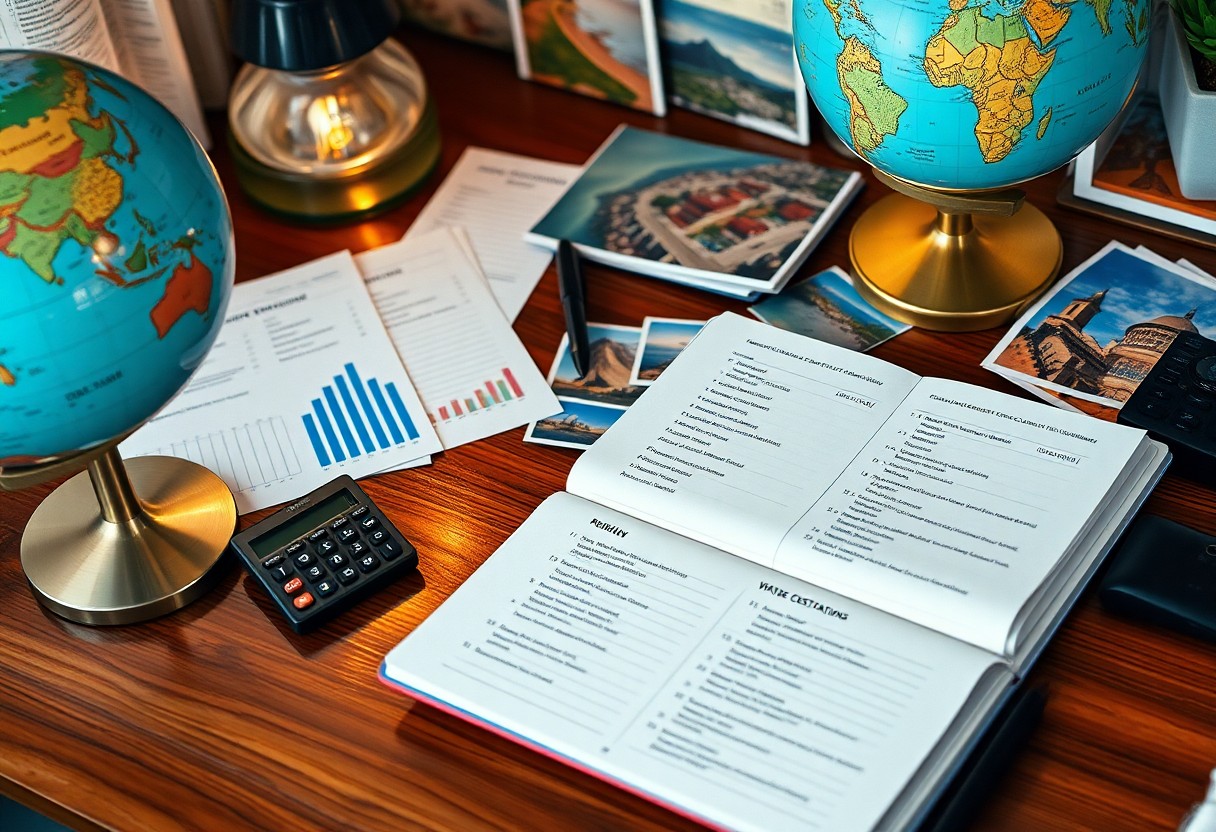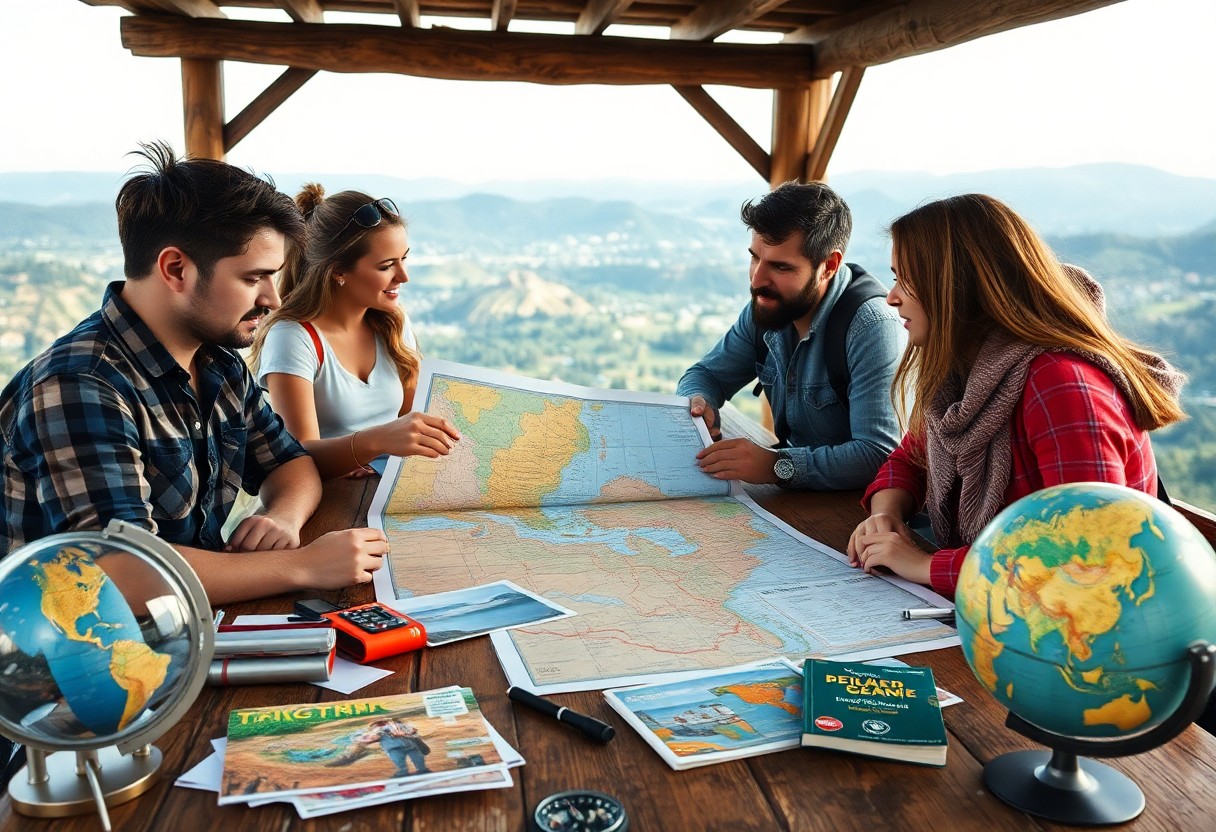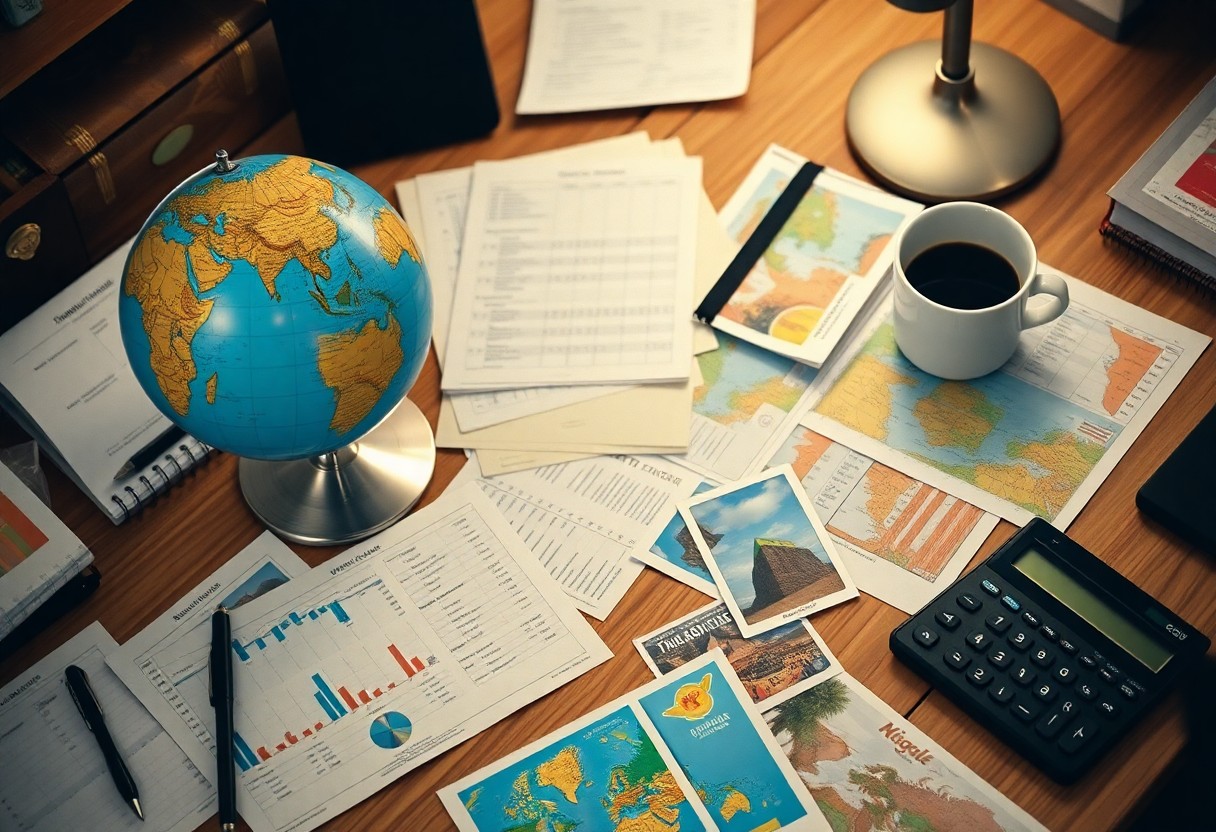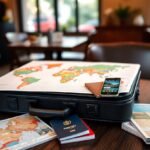
There’s a lot to consider when planning your travel budget, especially across diverse destinations with varying costs for your dream weaving on a dime. This guide helps you gauge approximate daily expenses for regions like Southeast Asia, Europe, South America, and Africa, empowering you to tailor your plans according to your priorities. By understanding local price trends and strategic tips, you’ll optimize your spending without compromising experiences, whether you’re backpacking, indulging in mid-range comforts, or exploring luxury options. Use this as a starting point to navigate your dream trip’s financial landscape with confidence and clarity.
Key Takeaways:
- Daily travel budgets vary widely by region, with Southeast Asia and Andean South America offering the most affordable options ($20–$55/day), while luxury travel in Europe and Africa can exceed $1,000/day.
- Mid-range travelers face significant inflation in accommodation and activities, especially in Europe where prices have surged post-pandemic, impacting hotel rates and guided experiences.
- Leveraging local booking platforms, ride-hailing apps, and timing travel during shoulder seasons can substantially reduce costs without compromising on cultural immersion.
- Experience-driven expenses such as guided tours, permits, and specialty activities now account for a larger portion of budgets, often comprising 25–40% for mid-range travelers.
- Strategic budget optimization includes using technological tools for transportation and accommodation comparisons, choosing peripheral cities, and engaging in culinary cost engineering through market shopping and lunch specials.
Stretching Your Dollar in Southeast Asia
Leveraging Southeast Asia’s diverse cost spectrum lets you tailor daily expenses from ultra-budget to mid-range with targeted choices. Opting for dorm stays at $5–$10 a night in Chiang Mai or Luang Prabang, combined with $2 street food meals, keeps your daily budget near $20. Alternatively, booking local tours directly—bypassing international agencies—cuts markups significantly. Transportation expenses fluctuate, so reserving overnight buses early or using ride-hailing apps like Grab can save both time and cash. Fine-tuning your itinerary around lower-cost hubs and shoulder season rates magnifies value without compromising immersion.
Backpacker Hotspots and Daily Costs
Cities like Hanoi, Bangkok, and Siem Reap serve as backpacker magnets, where daily budgets hover around $20–$30. Dorm beds fall between $5 and $12, while filling up on street food rarely surpasses $3 per meal. Transport within cities stays affordable, with local buses and motorbike taxis charging mere dollars. Longer-haul transport, such as Vietnam’s $15–$20 overnight buses or $30–$50 inter-island ferries in the Philippines, demands a bit more budgeting but remains manageable. These hotspots combine low lodging and food costs with abundant social opportunities, fueling vibrant backpacker communities on a dime.
Budgeting estimates for various destination types, based on typical daily travel costs and budgeting insights:
| Destination Type / Region | Estimated Daily Budget (Per Person) | Typical Trip Duration | Ballpark Total Budget (Per Person) | Notes / Cost Breakdown Highlights |
|---|---|---|---|---|
| Southeast Asia (e.g., Thailand, Vietnam, Cambodia) | $30 – $90 | 2-4 weeks | $600 – $2,520 | Low daily costs; food and accommodation cheap; activities moderate; budget backpacker to mid-range245 |
| Europe (e.g., Spain, Italy, Portugal) | $90 – $200 | 1 month | $2,700 – $6,000 | Mid to high daily costs; accommodation and transport significant; activities and food moderate to high24 |
| North America (e.g., USA, Puerto Rico, Costa Rica) | $50 – $235 | 1-2 weeks | $700 – $3,290 | Wide range; US and Hawaii higher end; Central America lower; flights can be significant23 |
| South America (e.g., Peru, Argentina, Colombia) | $40 – $150 | 2-3 weeks | $560 – $3,150 | Moderate daily costs; food and accommodation affordable; activities vary2 |
| Africa (e.g., South Africa, Egypt) | $60 – $180 | 1-3 weeks | $840 – $3,780 | Moderate to high; transport and activities can increase costs; some regions cheaper with local transport24 |
| Expensive Destinations (e.g., Iceland, Japan, Singapore, Norway) | $120 – $307+ | 1-2 weeks | $1,680 – $4,300+ | High daily costs; accommodation and transport expensive; activities add up quickly246 |
Additional Notes on Budget Categories (Based on Case Studies and Travel Budgeting Tips)
-
Transportation: ~10% of total budget in some long trips, but can be higher depending on flight costs and local transport16.
-
Accommodation: Often 30-40% of budget; discounts, rewards, or home exchanges can reduce costs1.
-
Food: Roughly 30-33%, varies by destination and dining style; grocery shopping lowers costs12.
-
Activities: Around 15-20%, depending on travel style and interest in tours, shows, entrance fees16.
-
Miscellaneous: Includes insurance, SIM cards, gifts, often 5-10%1.
Example Ballpark Budget Calculation
For a 2-week trip to Southeast Asia at $40/day per person:
-
14 days × $40 = $560 total per person
For a 1-month trip to Europe at $120/day per person:
-
30 days × $120 = $3,600 total per person
This table and figures provide a starting point for “Dream Weaving on a Dime” budgeting, allowing travelers to adjust based on personal preferences, travel style, and specific destination costs.
This summary integrates detailed daily budget ranges and travel cost insights from various regions and travel styles to help with initial budgeting for different destination types123456.
Mid-Range and Luxury Trends: Value vs. Expenditure
Allocating $60–$100 daily unlocks boutique stays and curated experiences like private guides or diving certifications. Yet, luxury accommodations in hotspots such as Bali’s Seminyak, commanding $300–$500 per night, reflect diminishing value compared to European counterparts priced at $600–$800. Insider bookings and flexible scheduling preserve quality while limiting overpayment. Such expenditures require discerning priorities—balancing experiential depth against sharply rising local luxury costs.
Expanding on this, the mid-range traveler gains access to boutique hotels averaging $60–$100 per day in Southeast Asia, where private tours and specialized experiences add layers to the itinerary. A private, three-day trek around Myanmar’s Inle Lake at roughly $250 typifies this segment’s unique offerings. Diving certifications in Indonesia’s Gili Islands, costing between $400 and $600 for a week, exemplify experiential investments that elevate a trip. However, luxury lodging in areas like Bali’s Seminyak district can command $300 to $500 per night, presenting a value proposition that’s often outmatched by European luxury properties priced closer to $600–$800 but delivering higher service standards. This intersection exposes travelers to diminishing returns, making local knowledge and strategic bookings imperative for maximizing both comfort and expenditure efficiency.
Budget Barriers and Opportunities in Europe
Europe’s travel costs vary sharply between Eastern and Western regions, creating both obstacles and openings to fit different budgets. You’ll find hostels in Budapest with beds priced at $15–$20, while Paris or Amsterdam dorms jump to $40–$60. Transportation options like Interrail passes at $250–$400 for 7–10 days balance out more expensive flights if booked ahead. Market shifts, especially in accommodation and activities, push daily expenses upward, but strategic choices—such as timing visits or targeting peripheral cities—can ease financial pressure without sacrificing experience quality.
Navigating Costs with Workarounds
Stretch your euro with creative workarounds: participating in work exchanges can eliminate lodging costs, while overnight buses and supermarket meals keep spending lean. Booking budget airline tickets like Ryanair six weeks in advance slashes transport expenses to $20–$50. Choosing Eastern European cities for accommodation lets you enjoy quality stays for half the price charged in Western capitals. Combining these tactics, you can manage $50–$70 daily without missing out on cultural immersion.
The Impact of Inflation on Mid-Range Travel
Mid-range travelers now face inflated costs, with daily budgets ranging from $100 to $300 largely due to accommodation and experiential tourism hikes. Three-star hotels in popular cities like Rome and Barcelona average $120–$160 per night, while daily expenses for museum admissions and guided tours add another $30–$50. Post-pandemic inflationary pressures have reshaped expectations and forced many to reconsider discretionary activities within their budgets.
Diving deeper, inflation has significantly strained mid-range budgets across Europe. Hotels that once thrived on steady demand now enforce price increases up to 40%, especially in high-tourism hubs during peak seasons. Popular guided tours and entry fees have added 20–50% atop pre-pandemic rates, squeezing discretionary spending. You’ll often find that combined accommodation and activity costs consume up to 70% of your daily budget, making careful prioritization and advance bookings important. Inflation has also shifted travel behaviors, encouraging more spatial and temporal flexibility to capitalize on shoulder season discounts and less tourist-saturated locations.
South America: Bargains and Bucket-List Expenses
South America offers a striking duality in travel budgets, ranging from incredibly affordable daily expenses in Andean nations to steep prices for iconic adventures. You can explore Bolivia or Ecuador with just $20–$40 per day, staying in hostels and enjoying local *almuerzo* meals under $3. However, pursuing bucket-list activities like the Inca Trail, Galápagos cruises, or Patagonia’s W Trek can rapidly escalate costs into the hundreds or thousands, demanding careful financial planning if these experiences are on your itinerary.
The Cost Spectrum: Andean Affordability to Amazonian Premiums
In the Andes, daily costs remain low: La Paz hostels often charge $8–$12 per night, while lunch menus come in under $3. Contrastingly, Amazonian excursions and exclusive wildlife experiences push budgets skyward. Think Galápagos cruises starting at $1,200, or private lodges deep in the Amazon demanding premium rates—you’ll need to factor these extremes into your overall spending to balance economy with adventure.
Urban versus Rural Budget Realities
Urban centers like Medellín offer affordable options with $35–$50/day covering private Airbnb rentals and efficient metro systems. By comparison, isolated rural gems such as Brazil’s Fernando de Noronha levy hefty environmental taxes of $70 daily, and pousadas running between $200–$300 a night, reflecting the premium on sustainability and exclusivity in remote areas.
Diving deeper into urban versus rural budget disparities, cities like Medellín benefit from developed infrastructure, affordable accommodations, and public transit that keep daily costs moderate without sacrificing comfort. You can comfortably rent private apartments and use the metro, drastically reducing transportation expenses and enabling access to local markets and eateries. Meanwhile, remote locations command a significant premium due to limited accessibility and conservation efforts. In Fernando de Noronha, mandatory environmental fees push daily costs upward, while lodging options largely consist of upscale pousadas that ensure environmental compliance and exclusivity. These rural premiums often inflate your accommodation and permit budgets, so aligning your itinerary with urban hubs or planning for these surcharges is vital for a realistic South American travel budget.
Africa’s Dual Cost Landscape
The African travel scene sharply contrasts budget frontiers with luxury sanctuaries, demanding tailored planning for your itinerary. Daily expenses can plunge to $20–$25 in Egypt or Rwanda, where hostels and shared minibuses dominate, yet soar to nearly $1,000 in Zambia or São Tomé due to sparse tourism infrastructure and elite safari lodges. Balancing these extremes requires smart choices, whether opting for group camping safaris at $200–$300/day in the Serengeti or splurging on exclusive stays exceeding $2,000/night. Navigating these dynamics often parallels strategies seen in entirely different industries—you might explore insights from Growing Your Automotive Service Team to better understand scaling and resource allocation in complex environments.
Budget Frontiers versus Luxury Havens
Affordable travel hubs like Rwanda and Egypt welcome you with $20–$25 daily budgets fueled by hostels and economical transit options, making Africa accessible to frugal adventurers. In stark contrast, safari exclusivity inflates costs dramatically; private guided tours in the Okavango Delta can run $800–$1,500/day, while luxury lodges in Sabi Sands command $2,000–$4,000/night. Choosing between these extremes shapes your experience and expenditure, urging strategic trade-offs between immersion and indulgence within Africa’s unique cost landscape.
Hidden Expenses in Urban Centers
Africa’s vibrant cities like Cape Town and Marrakech offer appealing mid-range options at $60–$80 daily, yet visa charges and domestic flights frequently tack on $200–$500, complicating budgeting. Anticipate fluctuating costs in urban hubs where local transport fees, tourist taxes, and food vendors may inflate your daily expenses unexpectedly, requiring vigilance and flexibility to maintain financial control.
Digging deeper reveals more subtle financial hurdles: urban visa requirements often vary by nationality and can involve substantial fees that sneak into your itinerary late. Internal flights within countries like South Africa easily reach $150–$300 per leg, while unofficial “tourist surcharges” on taxis or guides inflate costs beyond posted rates. Even accommodation taxes can differ widely, with some cities adding 10–15% on top of nightly rates. Factoring in these often overlooked sums ensures your budget accounts for the full price of urban African exploration without unwelcome surprises.
Factors Influencing Travel Budgets Globally
Global travel budgets are shaped by a complex web of factors, including regional inflation rates, currency fluctuations, and evolving tourism infrastructures. You’ll notice accommodation inflation hitting Europe hardest, whereas Southeast Asia offers some cushion through guesthouses. Transportation costs reflect a tug-of-war between low-cost carriers and rising fuel prices, causing unpredictability across continents. Experiences have surged in value, now claiming up to 40% of mid-range budgets, with iconic tours charging markedly more than pre-pandemic levels. Key influences include:
- Accommodation price volatility and its geographic disparities
- Transportation fare fluctuations driven by fuel and subsidy changes
- The steady rise in cost of guided tours and premium experiences
- Currency instability impacting purchasing power, especially in South America
Perceiving these variables allows you to adjust your plan dynamically and prioritize wisely.
The Accommodation Price Surge
Your lodging expenses have escalated significantly, with budget hotels worldwide rising 22% from 2023–2025 and European cities experiencing up to a 40% jump. You’ll find Southeast Asia somewhat insulated due to its proliferation of affordable guesthouses, while South America’s *hostales* maintain stability through informal cash dealings. High-demand periods and urban centers further magnify costs, transforming budget accommodations into a primary battleground for controlling daily expenses.
Transportation Fluctuations and Experience Costs
Regional flight pricing remains competitive, with Asia’s AirAsia and Europe’s Wizz Air offering fares between $20–$50, yet additional fees for checked baggage now hike costs by 30–50%. Overland travel unpredictably shifts—for instance, Argentina’s long-distance buses doubled fares after subsidy removals. On the experiential front, guided tours and activities have surged, consuming up to 40% of mid-level budgets. Signature excursions like Vietnam’s Ha Giang Loop and Morocco’s Sahara desert glamping have increased by 30–50%, demanding tighter budget scrutiny.
Delving deeper, transportation costs reveal stark regional contrasts: budget airlines still enable intra-continental mobility at low prices when booked well in advance, but ancillary fees—baggage, seat selection—can inflate final costs unexpectedly. In contrast, overland transport in regions like South America experiences dramatic cost swings tied to fuel pricing and local subsidies. Meanwhile, activity pricing marks a shift to premium experiences, with guided tours accounting for a rising share of expenditures. From Vietnam’s increasing Ha Giang motorbike tours to Sahara desert glamping hikes, you must weigh experiential indulgences carefully against their growing financial weight. Strategic timing and advance research become indispensable in managing these volatile components effectively.
Strategies for Frugal Wanderers
Pinpointing savings without sacrificing experience often means adopting a mindset geared toward adaptability and resourcefulness. Stitching together local transport options, tapping into neighborhood markets for meals, and prioritizing accommodations like guesthouses or dorms dulls the sharp edges of inflated budgets. Regional tactics—such as booking intercity buses in Latin America well in advance or leveraging Southeast Asia’s affordable ferry networks—can trim daily expenses by 20–30%. Layering such strategies with selective splurges on bucket-list activities creates a balanced approach that defines frugal yet fulfilling travel.
Embracing Flexibility in Travel Plans
Adjusting your itinerary around shoulder seasons and less-touristed areas translates into tangible savings, often cutting accommodation costs 30–50% in places like Southeast Asia’s monsoon months or Europe’s autumn lows. Choosing peripheral city hubs—Chiang Mai over Bangkok or Seville over Madrid—further widens budget room, shaving $25–$40 off nightly stays. Flexibility doesn’t only protect your wallet but invites deeper cultural immersion, as off-peak rhythms open doors to authentic local experiences absent in peak crowds.
Harnessing Technology for Better Budgeting
Tech tools serve as indispensable allies for the savvy traveler, with platforms like Rome2Rio mapping cost-efficient transport combos across Europe or Guestful surfacing last-minute hotel deals that routinely undercut standard rates by 15–25%. Additionally, embracing cryptocurrency payments at select South American hostels offers exclusive discounts, trimming up to 10% off stays. Digital budgeting apps synchronize expenses in real-time, empowering you to recalibrate daily spend confidently amidst fluctuating currency rates.
Leveraging technology goes beyond simple deal-finding; it reshapes your entire budgeting architecture. Aggregator websites consolidate transport options, allowing comparison between budget airlines like Ryanair and overland buses to identify optimal fare-to-time trade-offs. Cryptocurrency acceptance, not widespread but emerging in 15% of South American hostels, unlocks discounts inaccessible via traditional payments. Meanwhile, apps that track spending as you go ensure you don’t outpace your financial plan, especially crucial in regions experiencing rapid inflation. Integrating these digital resources into your travel routine systematically reduces overheads and enhances control over unpredictable expenses.
Summing up
Following this overview, you can better navigate the complexities of budgeting for diverse destinations by adapting your plans to regional cost variations and personal priorities. Whether you pursue affordable backpacking in Southeast Asia, mid-range experiences in Europe, or exclusive safaris in Africa, your financial strategy should combine flexibility, timing, and local insights. By balancing expenses on accommodation, transportation, and activities, you empower yourself to craft meaningful journeys without overspending, turning your dream travel ideas into achievable realities.
FAQ
Q1: What are typical daily budget ranges for backpackers in Southeast Asia?
A1: Backpackers in Southeast Asia can expect daily costs between $20 and $55, depending on their itinerary and country. For example, hostel dormitories in northern Thailand often cost $5–$10 per night, while street food meals typically range from $2 to $3. Countries like Laos and Cambodia tend to be on the lower end of the spectrum, around $20–$30 daily.
Q2: How have luxury travel prices in Europe changed in recent years?
A2: Luxury travel in Europe has seen significant inflation since 2022. For instance, the Belmond Venice Simplon-Orient-Express train journey now charges around £7,060 ($8,925) for a one-night trip, marking a 100% increase. Additionally, five-star hotels in cities like Paris can reach rates up to €1,200 per night during peak events like fashion weeks.
Q3: What strategies can travelers use to manage costs in South America’s diverse regions?
A3: Cost management in South America varies by location and activity. Travelers targeting urban centers like Medellín can operate on budgets of $35–$50 per day, covering private accommodation and transit. However, adventure activities like the Inca Trail or Galápagos cruises require significantly higher budgets ($500–$5,000). Employing local booking methods, choosing off-peak seasons, and opting for peripheral cities can help control expenses.
Q4: How do safari costs in Africa vary by experience level and location?
A4: Safari pricing differs widely depending on the exclusivity and location. Group camping safaris in the Serengeti usually cost $200–$300 per day, while private guided safaris in the Okavango Delta can range from $800 to $1,500 daily. Luxury lodge stays, such as those in Sabi Sands, may reach $2,000–$4,000 per day, reflecting high-end service and amenities.
Q5: What are some effective budgeting techniques for mid-range travelers across these regions?
A5: Mid-range travelers can optimize budgets by booking hotels during shoulder seasons, choosing accommodations in peripheral or secondary cities to save $20–$50 per night, and using transport aggregators like Rome2Rio for better deals. Additional savings come from dining at local markets or hawker centers where meals cost significantly less than restaurants, and leveraging local tour operators instead of international platforms to access more affordable experiences.
Citations:
- https://www.travelbugtonic.com/blog/travel-budget-planning
- https://listsbylukiih.com/trip-cost-breakdowns/
- https://www.reddit.com/r/travel/comments/1dyllbs/for_those_that_travel_3_times_per_year_how_much/
- https://www.globotreks.com/rtw/understanding-cost-destinations/
- https://www.curiousgoosetravel.com/post/budgeting-for-full-time-travel
- https://www.travellinggleefully.com/the-real-cost-of-full-time-travel/
- https://www.seekingneverland.com/how-much-should-i-budget-for-vacation/
- https://www.earthtrekkers.com/how-much-does-it-cost-to-travel-around-the-world/
- https://www.bankrate.com/banking/cost-of-vacation/
- https://info.better.co.nz/news/step-by-step-guide-to-planning-a-holiday-budget
Answer from Perplexity: pplx.ai/share







One thought on “Dream Weaving on a Dime: Initial ballpark budgeting for various destination types”